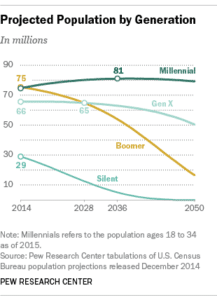King of the Hill: Healthcare Marketing and the Millennial Mindset
[First in a two-part series.] Not long ago, a momentous shift—demographically speaking—occurred in America. If, somehow, you missed the data temblor, some of your marketing and target audience assumptions might be off track.
Significantly, the Millennial generation—defined as individuals ages 18 to 34—pushed the long-standing, post-WWII Baby Boomers group (ages 51 to 69) out of the top spot to become the nation’s largest demographic group. What’s more, according to the respected Pew Research Center, “the Millennial generation continues to grow as young immigrants expand their ranks.
“The Census Bureau projects that the Millennial population was 74.8 million in 2014. By 2015 Millennials will increase in size to 75.3 million and become the biggest group. With immigration adding more numbers to its group than any other, the Millennial population is projected to peak in 2036 at 81.1 million.”
Boomers are no longer the giant bubble in the demographic pipeline. “Baby Boomers have always had an outsized presence compared with other generations. They were the largest generation and peaked at 78.8 million in 1999.”
And to further overshadow the boomer group: “The Gen X population (ages 35 to 50 in 2015) is projected to outnumber the Boomers by 2028.”
Reaching the hard-to-reach Millennial target audience
The size and the significance of the Millennial cohort isn’t in question. Representing as much as one-fourth of the American population, and upwards of $200 billion in annual buying power, everyone wants to make friends with the diverse and educated Millennial crowd.

This group is quite unlike Boomers and other generational sectors in that they are, by some studies, less trusting of traditional advertising. Effectively reaching and influencing adults in this group requires a fresh perspective about healthcare and healthcare marketing methods.
Deeply Connected Digital Natives. This is the first generation to have always had technology and digital connectivity. Computers and the Internet are their primary resource for information, social media and guidance regarding health decisions.
ComScore and others report that digital media—via both mobile and desktop devices—commands about 100 hours per month with this sector. Select options in Internet marketing are first-order considerations.
Being constantly connected is a two-way channel, providing the immediate means to voice opinions, react to others, compare social experiences, and offer direction and advice within large social networks and spheres of influence. What’s more, ever-present and instant access (to just about everything) feeds society’s craving for instant gratification and immediate answers.
Mobile devices are the ubiquitous gateway. Marketing has a large obligation to small screens. Mobile is where the audience resides and the power button is always on. About 85 percent of this generation own smartphones that “have become the staple of everyday life and the on-the-go tool of choice for consumers looking to catch up on emails, tap their social networks or even tweet about a recent sports game,” reports Nielsen. There is no gender divide in smartphone ownership, “men and women in the U.S. own smartphones almost equally.”
Conversely, this generation prefers to watch online (streaming and on-demand) content more than “regular television.” Consequently, mobile marketing is a vital first consideration in marketing to Millennials.
Continued in Part Two: Reaching the Hard-to-Reach Millennial Audience
See how Healthcare Success transforms doctor marketing by generating exposure and increasing qualified leads!








